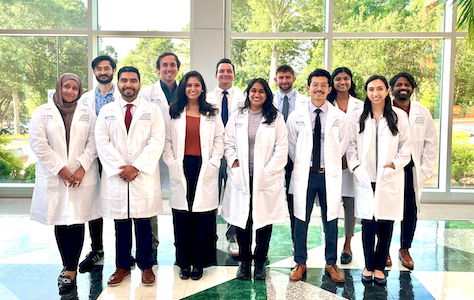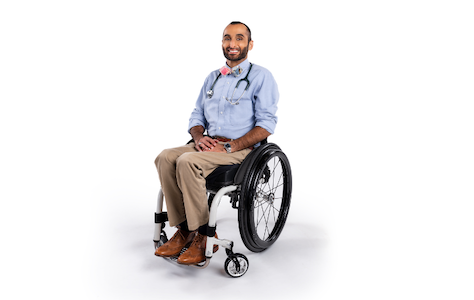Frequently Asked Questions
The Augusta University / University of Georgia Medical Partnership educates 60 Medical College of Georgia students per year. The partnership between Augusta University (AU) and the University of Georgia (UGA) was formed in 2009 to address the critical shortage of physicians in Georgia. Below are answers to some frequently asked questions about the Medical Partnership.
What Is The AU/UGA Medical Partnership?
The AU/UGA Medical Partnership is a collaborative effort between Augusta University and the University of Georgia to address the critical shortage of physicians in the state. This partnership established a regional medical campus in Athens that began educating 40 Medical College of Georgia students per year in the fall of 2010. The class size expanded to 60 students per class in 2021. Faculty and staff are made up of employees of both Augusta University and the University of Georgia. Our students are Medical College of Georgia students.
How Many Students Study In Athens?
The first 40 medical students began classes in August 2010. In 2021, the AU/UGA Medical Partnership expanded to educate 60 medical students per year.
When Did The First Medical Students Enroll In Athens?
The first class of medical students in Athens enrolled in August 2010 and graduated in May 2014.
Where Can I Find Admissions Information?
Students interested in attending the Medical College of Georgia at the AU/UGA Medical Partnership campus in Athens can apply through the AU Medical College of Georgia Office of Admissions.
Where Can I Learn More About Financial Aid?
The AU Office of Student Financial Aid is dedicated to providing guidance and assistance for students to help ease the financial burdens associated with their education
Where Are The Clerkship Sites Located?
Third- and fourth-year clerkship sites for students from the Athens campus are located at private practices, community clinics and hospitals in counties across northeast Georgia, including Hall, Jackson, Gwinnett, Barrow, Dekalb, Clayton, Newton, Oconee, Clarke, Madison, Elbert, Habersham, and Stephens counties. Affiliated hospitals include Piedmont Athens Regional Medical Center, St. Mary’s Health Care System, Northeast Georgia Medical Center, Barrow Regional Medical Center, Clearview Medical Center, Elbert Memorial Hospital, as well as hospitals in the Greater Atlanta area including the Shepherd Center, Children’s Healthcare of Atlanta, Gwinnett Medical Center, and Eastside Medical Center.
Who Governs The AU/UGA Medical Partnership?
The medical education program in Athens operates under a joint operating agreement with AU and UGA. The campus dean of the Athens program, Dr. Michelle “Shelley” Nuss, reports to AU Medical College of Georgia Dean Dr. David C. Hess with accountability to Dr. Jack Hu, Senior Vice President for Academic Affairs and Provost at the University of Georgia.
Where Are The Facilities For Medical Education In Athens Housed?
UGA has lead responsibility for identifying and developing appropriate facilities for the program in Athens. From the fall of 2010 to the summer of 2012, students were educated in the Interim Medical Partnership Building, a renovated historic building on the banks of the North Oconee River in Athens. In 2012, the Medical Partnership relocated to the UGA Health Sciences Campus, located on the 56-acre former U.S. Navy Supply Corps School property, located on the medical corridor of Prince Avenue in Athens. The University of Georgia College of Public Health is also located on the Health Sciences Campus.
What Is The Accreditation Status Of The Athens Program?
The Athens program was established under MCG’s accreditation and MCG will have the lead responsibility in governance issues pertaining directly to accreditation. MCG at AU is coordinating the program’s interactions with the Liaison Committee on Medical Education (LCME), the national body that determines accreditation of all allopathic medical programs.
What Is The History Of The Former Navy School Property In Athens?
The Navy Supply Corps School occupied a 56-acre site in Athens, which was designated for closure as part of the Navy’s Base Realignment and Closure (BRAC) process in 2005. That year, the Secretary of Defense recognized the Athens-Clarke County Local Redevelopment Authority (LRA) as the sole authority for the development and reuse plan for the site. In 2007, the LRA voted unanimously to approve the UGA proposal to establish a health sciences campus at the site. The Navy vacated the site in early 2011, and a U.S. Department of Education official signed the public conveyance deed transferring the property to the University of Georgia. The UGA Health Sciences Campus currently houses the AU/UGA Medical Partnership and the UGA College of Public Health.
What Are The Economic Costs Of Georgia’s Physician Shortage?
Georgia is currently ranked 38th in the country in active physician to population ratio according to the 2017 AAMC Georgia Physician Workforce Profile. Tripp Umbach, the nation’s leading medical education planning organization, estimates that a projected shortage of 1,500 primary care physicians in underserved areas would cost the State of Georgia $5.4 billion annually in delayed healthcare costs. According to Tripp Umbach, each physician that provides primary care in an underserved area saves the state $3.6 million annually for care that would have been provided in an emergency room. The AU/UGA Medical Partnership is working to alleviate this physician shortage.




